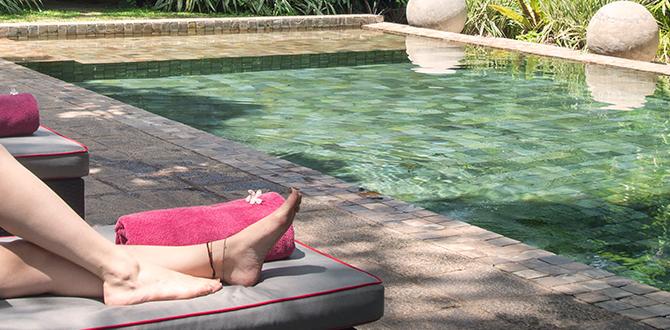The Azores are best visited during the shoulder seasons – April to May or September to October – to avoid peak crowds and enjoy pleasant weather. This strategy offers a fantastic balance of good weather, fewer tourists, and often better prices.
Dreaming of lush green landscapes, dramatic volcanic craters, and the vast blue ocean? The Azores islands in Portugal offer all this and more. But like any popular destination, the thought of battling crowds can dim the excitement. Figuring out the perfect time to visit the Azores when you can truly soak in the natural beauty without feeling overwhelmed is a common travel puzzle. Don’t worry, planning your serene Azorean escape is simpler than you think. This guide will walk you through the best times to experience these magical islands with peace and tranquility. Get ready to discover your own slice of paradise.
Understanding the Azores’ Seasons
The Azores, an archipelago located in the mid-Atlantic, experience a distinct maritime climate. This means mild temperatures year-round, but with significant variations in rainfall and sunshine depending on the season. Understanding these patterns is key to choosing the best time to visit for fewer crowds.
Peak Season: When Everyone Else Visits
The peak tourist season in the Azores generally runs from June to August. During these months, the weather is typically at its warmest and driest, with long daylight hours. This makes it the most popular time for international and European travelers to flock to the islands.
- Pros: Warmest weather, ideal for swimming and water activities, all tours and attractions are fully operational, vibrant atmosphere.
- Cons: Highest prices for accommodation and flights, crowded tourist spots, need to book well in advance.
Shoulder Seasons: The Sweet Spot for Serenity
The “shoulder seasons” are the periods just before and after the peak summer months. These are typically April, May, September, and October. These months offer a fantastic compromise: the weather is still very pleasant for exploring, but the majority of the summer crowds have either not yet arrived or have already departed.
- Pros: Fewer tourists, more affordable prices, still good weather for most activities, nature is at its most vibrant (especially in spring).
- Cons: Weather can be more unpredictable with a higher chance of rain, some seasonal businesses might have limited hours or be closed until peak season, water might be a bit cooler for swimming.
Off-Season: For the Truly Solitary Explorer
The off-season in the Azores spans from November to March. This is when the islands experience their coolest temperatures, highest rainfall, and shortest daylight hours. While not ideal for sunbathing, it’s a time of dramatic landscapes, lush greenery, and a profound sense of peace.
- Pros: Lowest prices, virtually no crowds, dramatic and moody landscapes, perfect for hiking in solitude.
- Cons: Significant chance of rain and strong winds, cooler temperatures, many tourist activities and restaurants may be closed, limited flight options.
The Best Time to Visit Without Crowds: Our Recommendation
Based on striking the perfect balance between agreeable weather and minimal crowds, we enthusiastically recommend the shoulder seasons.
Spring Shoulder: April & May
Visiting the Azores in April and May is like stepping into a vibrant, blooming paradise. The islands are incredibly green, wildflowers are in full bloom, and the temperatures are mild. You’ll find comfortable daytime temperatures perfect for hiking and sightseeing, though evenings can still be cool. The ocean is starting to warm up, but it’s still on the crisper side.
Why it’s great for avoiding crowds:
- The summer holiday rush hasn’t begun yet.
- Families often wait until school lets out in June.
- You get to experience nature’s rebirth without the peak visitor numbers.
Weather Considerations: While spring is beautiful, April showers are common. However, these are often short-lived, giving way to sunshine. Average temperatures range from 15°C to 20°C (59°F to 68°F).
Autumn Shoulder: September & October
September and October offer a wonderful continuation of good weather after the peak summer months. The sea is at its warmest from the summer heat, making it ideal for swimming and water sports. The autumn colors begin to emerge, adding another layer of beauty to the already stunning landscapes. The tourist infrastructure is still fully operational, but the masses have thinned out considerably.
Why it’s great for avoiding crowds:
- The summer vacationers have largely returned home.
- Travelers are transitioning to cooler weather destinations.
- You can enjoy warm seas and pleasant air temperatures with relative solitude.
Weather Considerations: While still pleasant, there’s an increased chance of rain as you move later into October. However, many days are still sunny and warm. Average temperatures range from 18°C to 23°C (64°F to 73°F).
Island-Specific Considerations
While the general seasons apply to the entire archipelago, each island has its unique charm and crowd dynamics. Here’s a quick look:
São Miguel (The Green Island)
As the largest and most populated island, São Miguel can attract more visitors year-round. Visiting in the shoulder seasons is particularly beneficial here for experiencing iconic spots like Sete Cidades and Furnas without feeling packed in.
Terceira (The Lilac Island)
Terceira has a more relaxed pace. While still popular, shoulder season visits still mean significantly fewer people, allowing you to fully appreciate Angra do Heroísmo’s historic charm.
Pico, Faial, and São Jorge (The Triangle Islands)
These islands are popular with nature enthusiasts and hikers. The shoulder seasons are perfect for tackling Mount Pico or whale watching without large groups.
Flores and Corvo (The Western Islands)
These remote islands are less visited. Their natural beauty is spectacular year-round, but fewer visitors during the shoulder seasons only enhance the feeling of discovering a hidden gem.
| Time of Year | Crowd Levels | Weather | Activity Suitability | Price Range |
|---|---|---|---|---|
| December – March (Off-Season) | Very Low | Cool, Wet, Windy | Hiking (if prepared), exploring towns | Lowest |
| April – May (Spring Shoulder) | Low | Mild, Increasing Sunshine, Showers Possible | Hiking, sightseeing, whale watching (early) | Moderate |
| June – August (Peak Season) | High | Warm, Sunny, Dry | All activities, swimming, sunbathing | Highest |
| September – October (Autumn Shoulder) | Low | Warm, Pleasant, Rain Possible (later) | Water activities, hiking, sightseeing | Moderate |
Essential Tips for a Crowd-Free Azorean Adventure
Beyond choosing the right dates, a few smart strategies can ensure your trip is as peaceful and enjoyable as possible.
Book Flights and Ferries in Advance
Even during the shoulder seasons, popular routes can fill up. Booking your flights to the Azores and inter-island ferry tickets ahead of time, especially if you have specific travel dates, can save you stress and potentially money. Check out official airlines like Azores Airlines for flight information.
Accommodation Choices Matter
Consider staying in smaller towns or on less-visited islands. Look for guesthouses, rural tourism accommodations (Quintas), or vacation rentals rather than large hotels. This often provides a more authentic experience and helps you avoid concentrated tourist hubs.
Embrace Early Mornings and Late Afternoons
If you do find yourself in a popular spot, the easiest way to beat the midday rush is to visit iconic locations very early in the morning or later in the afternoon. Sunrise at Miradouro da Senhora do Monte on São Miguel (if accessible and safe) or exploring the Furnas Lake area before 10 AM can offer a completely different, serene experience compared to visiting at noon.
Consider Less Popular Activities
While everyone flocks to the famous viewpoints, explore other natural wonders. Many islands have lesser-known hiking trails, secluded hot springs, or charming villages that offer just as much beauty with far fewer visitors.
Travel During the Week
If your schedule allows, try to plan your inter-island travel or visits to major attractions on weekdays rather than weekends. This can further reduce the number of people you encounter.
Plan for Flexibility, Especially with Weather
The Azores are known for their changeable weather. Even in the shoulder seasons, a rainy day can happen. Have backup activities in mind, such as visiting museums, thermal baths, or enjoying local cuisine. This flexibility ensures that a bit of rain doesn’t derail your plans or lead you to the same crowded indoor attractions everyone else is visiting.
What to Pack for Shoulder Season Travel
Packing smartly is key to comfort and preparedness, especially when the weather can be a bit unpredictable.
Clothing Essentials:
- Layers: Pack lightweight, breathable layers. Think t-shirts, long-sleeved shirts, and a fleece or sweater.
- Waterproof Outerwear: A good quality waterproof and windproof jacket is essential.
- Comfortable Footwear: Sturdy, waterproof hiking boots or walking shoes are a must for exploring.
- Quick-Dry Pants: Ideal for hiking and changeable weather.
- Swimsuit: Even if the sea is cool, the thermal pools will be inviting!
- Socks: Plenty of comfortable socks, including wool or synthetic for hiking.
Other Essentials:
- Sun Protection: Sunscreen, sunglasses, and a hat. The Atlantic sun can be strong, even if it’s not scorching hot.
- Reusable Water Bottle: Stay hydrated and reduce plastic waste. Check out WWF’s guidance on reducing plastic.
- Camera: To capture those stunning Azorean landscapes.
- Small Backpack: For day trips to carry essentials like water, snacks, and a jacket.
- Travel Adapter/Power Bank: Always handy for keeping your devices charged.
For travelers who may need additional comfort and security, like those using adult or child diapers, packing these items discreetly and ensuring they are readily accessible is also vital. Consider compact, absorbent options for day trips that can easily fit into your daypack. Traveling with items like Depend for Men or Always Discreet Pads can offer peace of mind for long travel days or excursions, allowing you to focus on the experience.
Activities to Enjoy in the Azores
The Azores offer a wealth of activities, with the shoulder seasons providing perfect conditions for many of them.
Hiking and Trekking
With a network of well-maintained trails, the Azores are a hiker’s paradise. The shoulder seasons offer mild temperatures and fewer people, making trails like the one to Lagoa do Fogo on São Miguel or the trails around Flores incredibly rewarding.
Whale and Dolphin Watching
The Azores are one of the best places in the world for whale and dolphin watching. Peak season for sightings is generally from April to October. Visiting in September or October means you can enjoy excellent whale watching opportunities with fewer boats and tourists out on the water.
Thermal Pools and Spas
Soaking in the natural thermal pools is a must. Places like Furnas on São Miguel or the Ferraria hot springs offer therapeutic relaxation. These are enjoyable year-round, but visiting in slightly cooler shoulder seasons can make the warm waters even more appealing.
Exploring Volcanic Landscapes
From the calderas of Sete Cidades to the lava tubes on Pico, the volcanic origins of the islands are spectacular. Shoulder season visits allow for more unhurried exploration of these geological wonders.
Canyoning and Adventure Sports
For the adventurous, activities like canyoning, kayaking, and surfing are popular. The shoulder months can offer good conditions, though it’s always wise to check with local guides for the best opportunities and safety advice.
Cultural and Gastronomic Tours
Explore the charming towns, visit local producers of cheese and wine, and sample Azorean cuisine. Fewer crowds mean more personal interaction with locals and a more immersive cultural experience.
Frequently Asked Questions (FAQ)
Q1: Is it too cold to swim in the Azores in May or September?
A1: The ocean temperature is at its warmest in September after the summer heat, making it very pleasant for swimming. In May, the water can be cooler, but still comfortable for many, especially in comparison to the air temperature. Plus, the thermal pools are always a warm option!
Q2: Will I be able to visit all the main attractions if I go in April or October?
A2: Yes, most attractions, tours, and restaurants remain open throughout the shoulder seasons. While some smaller, seasonal businesses might have slightly reduced hours, the major sights and activities are fully accessible.
Q3: Is there a risk of hurricanes hitting the Azores during the shoulder season?
A3: The Azores are located in the Atlantic, and while hurricanes are rare, they can potentially occur between August and October. However, the probability is low, and the islands are not in a typical hurricane zone. The weather is more likely to be affected by typical Atlantic storms.
Q4: Are flights and accommodation significantly cheaper in the shoulder season?
A4: Generally, yes. You can expect to find noticeably lower prices for flights and accommodation during April, May, September, and October compared to the peak summer months of June to August. It’s a great way to save money while still enjoying good weather.
Q5: What is the weather really like in the Azores in April?
A5: April is spring in the Azores. Expect mild temperatures, typically ranging from 15°C to 18°C (59°F to 64°F). It is also one of the wetter months, so be prepared for sunshine and occasional rain showers. Layers are key!
Q6: Is it possible to hike Mount Pico in the shoulder season?
A6: Absolutely! Hiking Mount Pico is possible and often more enjoyable in the shoulder seasons. The trails are usually less crowded, and the temperatures are more manageable than in the peak of summer. However, always check the weather forecast before attempting the climb, as conditions can change rapidly.
Q7: What are the biggest advantages of visiting the Azores without crowds?
A7: The biggest advantages are a more peaceful and authentic experience. You’ll encounter fewer people at popular viewpoints, on hiking trails, and in restaurants. This allows for better photo opportunities, easier parking, more interaction with locals, and a deeper connection with the stunning natural environment.
Conclusion
For travelers dreaming of the Azores’ volcanic grandeur, emerald landscapes, and azure waters, but wishing to steer clear of the throngs of summer tourists, the answer is clear: embrace the shoulder seasons. Visiting in April, May, September, or October strikes that perfect chord between delightful weather and a tranquil atmosphere. You’ll find yourself with more space to breathe, more opportunities to connect with the nature and culture, and often, a kinder impact on your wallet. Whether you’re drawn by the blooming flora of spring or the lingering warmth of autumn seas, these periods offer an Azorean experience that is both spectacular and serene.
Remember to pack layers, book in advance, and remain open to the wonderful unpredictability of island life. By planning your visit during these ideal times, you’re setting yourself up for a journey filled with breathtaking sights and peaceful moments, creating travel memories that truly are essential. Your incredible, crowd-free Azorean adventure awaits!






